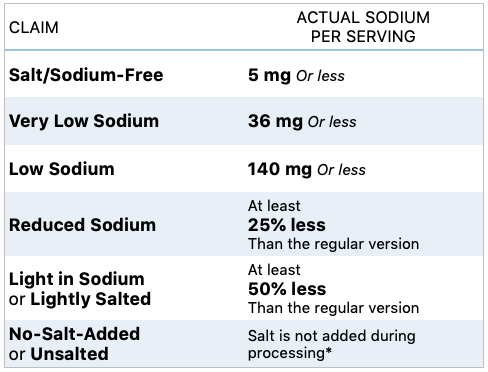
Why Too Much — Or Too Little — Sodium Can Negatively Impact Heart Failure Patients
APRIL 17, 2023
By THE CORMEUM TEAM
If you’re living with heart failure (HF), you’ve probably been told to cut back on sodium. While it’s important to be aware of sodium consumption, completely eliminating sodium may not be the best plan. The Journal of the American College of Cardiology recently published a study showing that HF patients may need balance more than total abstinence when it comes to sodium.
According to the study authors, who performed a meta-analysis of randomized trials that included 3,4999 HF patients, “in patients with heart failure, sodium restriction resulted in increased mortality.”
The study concludes with a recommendation that may sound foreign to HF patients who are constantly asked to monitor salt intake: restricting sodium intake may not benefit all HF patients and could be harmful, and more research should be done on sodium recommendations for HF patients.
It’s important to note that this is a single study. And while it is good to keep up with regular research when it comes to HF, each individual should follow their own provider’s recommendations.
In light of this recent study, this post will dig into all things sodium in HF, including:
- What it is (and what it isn’t)
- Why it is an important metric to track for HF patients
- Where and how we get it
- Tips for managing sodium in everyday life
Sodium and HF Patients: What You Need to Know
Here’s what we know about sodium: The amount of sodium in our bodies can directly affect heart functions. Inadequate sodium levels can lead to sodium retention in the blood, making it denser, which can increase blood pressure. Excess sodium can cause the body to retain fluids and increase blood pressure. High blood pressure can increase the risk of further heart damage in HF patients.
Too Much vs. Not Enough: What’s the Right Answer?
The answer is a non-answer: it depends. The exact amount of restriction vs. intake of sodium for HF patients will look different for everyone. It can vary greatly depending on things like age, blood pressure and current sodium consumption. General sodium consumption guidelines may not apply to your specific situation. This new research may not apply in your case either.
If you’re interested in what this means for you, bring this new research to your provider and discuss it with your care team. It may move the needle on how much sodium you include in your diet, but it may not. The most important thing is that you’re upfront about any diet and lifestyle changes before you make them. Together, you and your provider can determine the best amount of sodium for your specific HF needs.
It’s also a good idea to meet with a dietician after you’ve received your health care provider’s sodium recommendations. You and your health care team can make a plan for how to get the right amount of sodium each day.
What is Sodium? (Hint: It’s Not the Same as Salt)
People frequently equate sodium and salt, but there is a difference. Sodium is a mineral found in table salt. Table salt (sodium chloride) is made up of 40% sodium and 60% chloride. One teaspoon of table salt contains 2,400mg of sodium. Sodium is found naturally in most foods (including healthy foods like celery or milk). It also shows up in some surprising places, like baking soda and OTC and prescription drugs.
So, it’s pretty much everywhere, which helps explain why the average American consumes 47% more sodium than the FDA-recommended intake of 2,300 mg daily. Yet table salt and natural occurrences only make up about 25% of our daily sodium intake. Where does the rest come from? A whopping 70% comes from processed or restaurant foods. Here’s a closer look at some common sodium-heavy sources.
- Eating out equals more sodium. Many fast food and large chain restaurants get preservative-packed elements and assemble them to make their meals. Try to find restaurants serving local, fresh fare. If that’s not possible, find out how the food is prepared before it hits your plate. Inquire about nutrition facts from the menu to see sodium numbers for yourself. Ask for sauces/dressings on the side, request veggies without seasoning or order several healthier a la carte options to build your own meal.
- It’s in the can. Many canned fruits and vegetables have sodium added to increase their shelf life. Fresh and frozen options don’t go through the same process, leaving them with lower sodium content. Buying “no salt added” options and rinsing canned products before cooking with them are ways to reduce sodium.
- Soup, there it is. One serving of canned chunky vegetable beef soup has 1,870 mg of sodium. A bowl of restaurant french onion soup contains 1680 mg of sodium. Making soup from fresh ingredients gives you more control over your soup’s sodium content.
- Processed means salt. Processed, prepackaged and frozen meals are packed with sodium. Instead of reaching for that microwave meal, try making two or three meals to disperse into ready-to-eat containers and freeze them. You can have the convenience of that weekday TV dinner without all the extra sodium.
- The sodium’s in the sauce. Many condiments are sodium-heavy. Check your favorite salad dressing, too. Even reduced fat or low-calorie options are sometimes packed with sodium. The same goes for hot sauce, especially if soy sauce is the main ingredient.
For more information about sneaky sodium culprits, check out this list of sodium levels in popular food choices.
Try These Recipes
Cooking for yourself is the best way to know exactly what’s in your food. These are a few of our favorites created by Chef Ken Bergeron.
Sodium Management Made Simple
Knowing what’s in your food can give you a starting point when regulating sodium intake with heart failure. As you read food labels and packaging, overlook the percent daily values and focus on the milligrams (mg) per serving.
Pay special attention to per-serving language. How many servings are you eating in a sitting? If you’re not sure, go ahead and measure a few servings to get a better idea. Phrases like lower sodium and reduced sodium can be misleading.
Here’s what those claims actually mean:

*May not be salt/sodium-free unless specifically stated.
If reading food labels feels overwhelming, focus on one or two items per shopping trip. After a few trips to the grocery store, you’ll probably look at sodium milligram numbers without giving it much thought.
Check Sodium Levels
Your medical provider may order a blood test to measure your body’s sodium levels. This is done via a simple blood draw and may involve fasting beforehand. Sodium levels are often measured as a part of an electrolyte panel, basic metabolic panel (BMP) or comprehensive metabolic panel (CMP). Your medical team may make recommendations based on these findings.
Striking a Balance
What should sodium intake for heart failure look like in your diet? You and your health care provider can team up to find the right amount of sodium for you. Does the thought of making dietary changes feel overwhelming? Tracking your sodium intake can help you take control of your heart health. Tools like the Cormeum app can help you track food choices and share the results with your health care provider.

